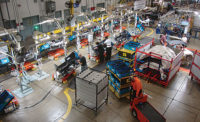There is no such thing as "average" in the ergonomics world. All people are unique, especially when it comes to arms, backs, elbows, fingers, hands, necks, shoulders and wrists.
In fact, industrial ergonomics is full of variables. A workstation height that "feels right" to one person may be awkward to another. A fastening tool that an operator on the morning shift claims has a "weird handle" may feel perfectly normal to a different individual on the afternoon shift.
That lack of clear cut, black-and-white answers often makes ergonomic implementation a frustrating task for manufacturing engineers. "They are being told to design jobs and equipment ergonomically," notes Kevin Costello, president of United States Ergonomics (Jericho, NY). "However, they are often not given solid references for what that means, such as ‘How much repetition is too much?’ or ‘Do I design for the small person or the large person?’"
Unfortunately, there is no simple answer to such questions. For instance, the risk of injury during a lifting task depends on numerous variables, such as the size of the object being lifted, the distance of the object from the body, the travel distance of the load, the posture of the worker, the velocity and acceleration of the lift, the frequency of lifting and the physical capabilities of the individual. In other words, lifting activities are too complex to apply a generic weight limit.
Fortunately, there are guidelines that can be used to estimate injury risk and establish suitable interventions or accommodations. But, "accurately quantifying an individual’s performance within appropriate biomechanical and physiological limits is not for amateurs," warns Costello.
Ergonomics tends to be a gray area, because it’s a mixture of art and science, and it deals with human emotion and behavior. "Many of these areas are gray, rather than black and white, so many ergonomists tend to use the guidelines vs. rules approach, especially with issues such as repetition," says Chris McIntyre, president of Ergonomics at Work Inc. (Kitchener, ON).
OSHA’s New Plan
The U.S. Occupational Safety and Health Administration (OSHA, Washington, DC) has abandoned its ambitious plan to enact an ergonomics rule. Instead, the organization has shifted its priorities to developing guidelines for reducing injuries such as carpal tunnel syndrome, tendinitis and lower back pain that can result from repeated motions at work.Last month, OSHA unveiled a new ergonomics plan that focuses on industry-targeted guidelines. "We know that one size does not fit all," says John Henshaw, OSHA administrator. He claims that guidelines can be developed more quickly than a mandatory standard and can be more flexible, depending on the industry and the facility.
The new OSHA policy comes one year after the controversial Clinton administration ergonomics rule was repealed in Congress shortly after George Bush became president. It also comes 15 years after OSHA cited four Chrysler assembly plants for ergonomic hazards, which raised widespread awareness of musculoskeletal disorders.
According to Henshaw, a voluntary approach to ergonomics will work better than the rescinded Clinton rules because it will be adaptable to specific industries and will cost companies less to carry out. By the end of the year, OSHA will begin issuing industry-specific guidelines.
Henshaw defines a guideline as "a tool to assist employers in recognizing and controlling hazards. It is voluntary. Guidelines that OSHA develops will provide information to help employers identify ergonomic hazards in their workplaces and implement feasible measures to control those hazards.
"Guidelines are more flexible than standards," adds Henshaw. "They can be developed quickly and can be changed easily as new information becomes avail-able with scientific advances. Guidelines make it easier for employers to adopt innovative programs to suit their workplaces, rather than inflexible, one-size-fits-all solutions to issues that may be unique to the industry or facility."
Labor unions, such as the AFL-CIO (Washington, DC), criticize the new OSHA plan. They claim that it fails to require employers to make changes in the workplace, such as buying new equipment, adjusting the height of workstations, repositioning tools and providing material handling equipment, to reduce repetitive stress injuries.
A Guiding Light
Most ergonomics experts applaud OSHA’s recent decision. "Guidelines are good because they state the intent, such as ‘to improve a person’s comfort,’ rather than prescribing one specific solution for all situations," says Alan Hedge, Ph.D., director of the human factors and ergonomics laboratory at Cornell University (Ithaca, NY). "With issues of repetition, it’s far from clear cut. It’s like medicine; there are often several solutions for an ergonomic problem and the skill is in analyzing the problem and figuring out the best solution for that situation."According to Dr. Hedge, ergonomics is based in science. "Interventions need to be verifiable and repeatable," he points out. "Benchmarks provide a useful way of knowing how well or poorly a workplace is working in terms of ergonomic factors. Without this kind of framework, ergonomics degenerates into opinions and hearsay."
"Throw in the additional factors associated with human variation, and it doesn’t make sense to have hard and fast rules," argues John Boyle, a design and ergonomics consultant at Munro & Associates Inc. (Troy, MI), "It does make sense to use some guidelines, with the understanding that they must be used intelligently.
"People come in many more shapes and sizes than machines," explains Boyle. "We need gray areas and guidelines to allow for that. We don’t expect a forklift and a front-end loader to do the same jobs equally well, but they both lift things up. We need to think of the differences between people in the same way."
Many ergonomic issues require interpretation, which can frustrate engineers who tend to see things in black and white. "Engineers need something to guide them in a direction," says McIntyre. "Objective guidelines help evaluate where you are and where you should be going."
It is very important to have solid references, benchmarks and guidelines before tackling ergonomic concerns. "Engineers are a very conservative group on the whole, and when they are working with unknowns, they will estimate, and work conservatively toward a solution," adds Boyle. "They will get the job done even if they have incomplete information. What does this result in? Workstation setups designed to extremes instead of toward optimization; workstations that are inefficient and are eventually redesigned during cost reduction efforts—someArial with resulting ergonomic issues."
Manufacturing engineers are not always given solid references, benchmarks and guidelines to use when addressing ergonomic issues and concerns. "Ergonomists have done a lousy job presenting data to engineers in a consumable format," argues Chris McIntyre. "The information should be more user friendly."
According to Boyle, many ergonomists are still writing guidelines in health and safety terms. "Guidelines must be written in terms that engineers can use while doing the rest of their job," he explains.
"When I want to tell an engineer how to design a workstation for ergonomics, I have a checklist that is defined by tool setup, parts flow in and parts flow out. It follows the line of thinking that is already used for workstation setup, so that it enhances the work being done—maybe helping to focus the work—rather than adding to the workload."
Ergonomists typically use more qualitative measures than quantitative measures. "There is a tremendous amount of research needed to better understand musculoskeletal disorders," notes Joy Ebben, Ph.D., an ergonomist at IAC Industries (Brea, CA). "We have targeted important risk factors but we have not yet clearly defined how the risk factors interact. There are also many questions regarding organizational issues, individual differences, duration and recovery.
"It is just going to take more time and research to move the science of ergonomics to be more ‘black and white,’" adds Dr. Ebben. "Usually the ergonomics topic focuses on musculoskeletal disorders. This is only one aspect of ergonomics. In the area of human factors engineering, there is a wealth of guidelines for designing equipment to be safe, usable with minimum error and easy to learn. This information is extremely valuable to engineers trained in how to apply the guidelines.
"Often, engineers are not trained to understand the full range of variables that should be considered prior to establishing guidelines," she points out. "These variables are not only musculoskeletal risk factors but other aspects of the workplace including work schedules, salary incentives, training and design constraints."
Repetition, Repetition
"How much repetition is too much?" is one of the most frequently asked ergonomic questions. "It’s also the most difficult one to answer," says Chris McIntyre. "It depends on hand frequency and how much force is being exerted. Unfortunately, no two hand movements are ever the same."The risk of injury is a combination of at least four factorsforce, posture, stress and repetition. "High repetition of forceful movements in a deviated posture under stressful conditions gives the greatest risk of an injury," says Dr. Hedge. "Repetition without any of the other risk factors isn’t necessarily that hazardous."
Dr. Hedge recommends conducting a task analysis to determine those tasks with the greatest repetition. "Look at postural issues," he says. "Look at injury records. Ask workers about levels of musculoskeletal discomfort. Try to break up the repetition by interspersing periods of work with brief rest breaks."
John Boyle believes "there is enough data out there for companies to establish guidelines based on similar job tasks, and what has caused problems previously." But, he says it may be more important to address repetition as an efficiency issue and look at eliminating it altogether.
Boyle suggests asking questions such as: Why do you need the repetition in the first place? Is there a product available that would allow me to replace a highly repetitive task with a single application task? Is there a product available that would allow me to cut the repetition in half? "Most people don’t have the time to stop and think in this way," says Boyle. "But, my experience is that when they do, they are able to make significant changes."
Some ergonomic experts believe there is no best way to establish guidelines to determine how much repetition is too much. "Repetition is only one risk factor and must be evaluated in terms of other factors such as force, posture, cold and vibration," warns Dr. Ebben. "However, keeping in mind that cumulative trauma disorders develop over time, I recommend that employers monitor their employees’ comfort and discomfort in order to identify tasks that may need redesign to reduce the risk of the development of cumulative trauma.
"When a questionable task is defined, an ergonomist can evaluate the various risk factors and make a recommendation of how to reduce the risk. It may not necessarily be a reduction in repetition but rather force reduction change in a tool."
According to Dr. Ebben, there is often more than one approach to reduce the risk of musculoskeletal disorders. For example, it may not be feasible to reduce repetition but it may be feasible to increase recovery time.
It is also difficult to answer the question of "how much force is too much?" However, there are existing guidelines for lift, push, pull, carry, button pushing, wheel turning and other tasks that can be used.
"A guideline that I use in the field is ‘when in doubt, reduce force,’ " concludes Dr. Ebben. "How much I need to reduce the force depends upon the other risk factors, work environment, the individual, and so on. It may not be as important to reduce the force to a specific level but to reduce it sufficiently for the individual worker so they can work comfortably and meet production expectations."



